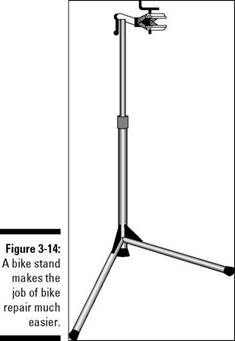Considering how much space you need
Although it’d be nice to have an individual room in which to set up your own bike shop, most people don’t have that much extra space. Fortunately, you don’t need a large space. You just need an area that’s long enough and wide enough to hold your bike and possibly a workbench, with enough space in between that you can operate comfortably. Part of a basement or garage can be a solution, or even the corner of a room.
Factoring in ventilation
Look for a space with proper ventilation. Vapors from cleaners and degreasers can be irritating to some, so unless you want to be seeing colors and taking a ride on a magic carpet instead of a bike, you need access to plenty of fresh air.
|
tNG/ |
|
|
Not all products are pleasing to the nose. Go to the back of the bike shop and you’ll know what we mean. If you do this work in a small unventilated area, you’re asking for problems.
The products that you’ll accumulate as a part of your bike shop should be used with caution. Be sure to
✓ Read and follow all warning labels both for tools and chemicals.
✓ Wear rubber gloves to protect your skin from chemicals.
✓ Wear safety glasses when cutting, grinding, or drilling.
✓ Use tools that are designed for your bike’s components. Forcing a tool that doesn’t quite fit a part could cause it to slip or break, which can cause injury.
When in doubt, consult with your owner’s manual or your local bike shop.
Looking into the light(ing)
Also pay attention to lighting. Extra lighting can be helpful so you don’t strain your eyes while working on small, intricate parts. A droplight hung from the ceiling will give you the ability to move the light as needed, to reach those poorly lit parts of your bike.
Wrangling a workbench
|
|
You’ll need a flat surface for many repair and maintenance procedures. You may need to lay out parts, cut a cable, or steady a hand when setting bearings. This is where a workbench comes in handy. In fact, what would a shop be without a workbench? You wouldn’t have a kitchen with a counter, would you?
Look for a bench with enough flat space to lay out your tools and parts, and one that’s solid enough that if you need to strike something with a hammer or attach a vise, there’ll be enough support.
Because clutter can build up quickly, maintain some space under the workbench to stow away trash, rags, cleaning cloths, and spare parts. This will go a long way toward keeping your space organized and impressing your housemates enough that they’ll actually visit or bring you a drink once in a while.
Focusing on storage
|
|
To organize your tools, you’ll want either a toolbox (to put your tools in) or a pegboard (to hang your tools on). Most hardware stores supply long and short hooks that work with pegboards.
If you’re working with a pegboard, trace the outline of each tool onto the board with a marker, and you’ll always remember what goes where. This technique will also keep you from misplacing a tool and blaming it on the kids.
Banking on a bike stand
If you’re serious about doing your own bike repair and maintenance, and you’ve invested in the right tools for the job, you may want to think about buying a bike stand (see Figure 3-14).
Working on a bike when it’s suspended off the ground is much easier. You can raise, lower, and rotate the bike to get exactly the position you want.
Plus, you’re not hunched down over your bike — your back will thank you for that when you’re finished.
|
|
|
|
A number of different types of bike stands are on the market. Prices range from under $100 to several hundred dollars. The best stands have adjustable heights and allow you to rotate the bike 360 degrees. Some are freestanding, while others attach to a wall or worktable (which can be useful in tight spaces). Some models are foldable for easy storage when you’re finished — useful if you’re short on space. In general, the more-expensive models have designs that provide greater stability, which is useful when applying leverage to your bike.
If you don’t have the money for a stand, you can get creative and suspend your bike with hooks connected to the ceiling. Although many jobs are much easier if your bike is immobilized by a stand, you can do most jobs with a suspended bike.
When clamping your bike to the bike stand, consult the owner’s manual for your bike. Most bikes can be clamped at the seat post or frame, but some bike manufacturers recommend that you avoid clamping or over-clamping the frame. This is especially true for carbon-fiber bikes, which should never be clamped in traditional stands.
|
iNG/ |
|
|
Some bikes can be turned upside-down and supported by the handlebars and saddle. If you do this, be careful to move the shifters out of the way so that they aren’t damaged. The clamps that hold the shifters in place can be loosened with an Allen wrench and tightened when you return them to their original position.
Working on bikes can get pretty messy. You’re dealing with bottles of oil, tubes of grease, dirt, grime, and cleaning solutions. After some procedures, you’ll feel like someone should spray you off with a hose before you leave the shop. To protect your floor and to facilitate cleaning up afterward, always place a mat, dropcloth, or extra piece of carpet or flooring under your bike. You’ll be thankful you did.
|
|







